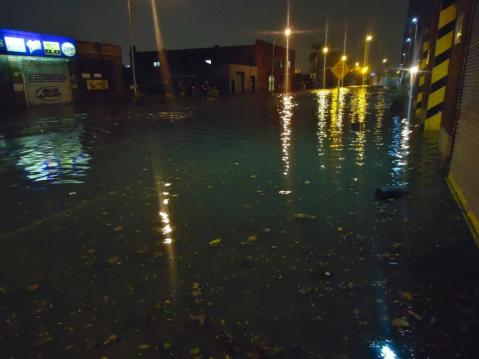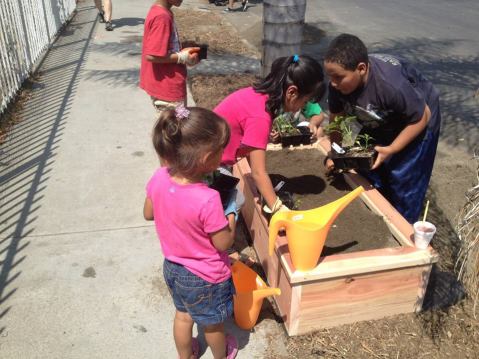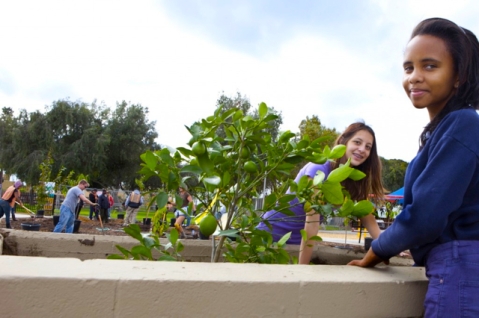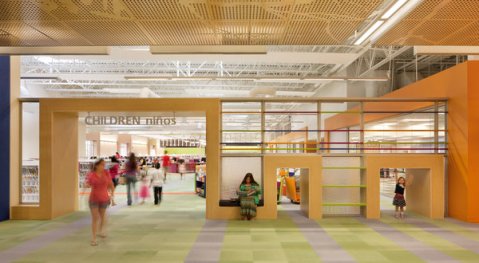LA Waves Parkway Planting Permits to Create Opportunities in Food Deserts
In my last post, I highlighted an innovative program in Toronto which brings a mobile produce market to communities who lack access to affordable and healthy food. In an effort to address healthy food access in similarly underserved neighborhoods across the US, some community residents have literally taken action into their own hands by transforming underutilized and sometimes unlikely patches of land into “guerrilla” gardens.
Trees, wildflowers, herbs, fruits and vegetables pop up in vacant lots, alleys, tree pits and even parkways (the planted strip of land between the curb and the sidewalk), providing aesthetic value, helping to oxygenated the air and clean the soil, as well as providing families with an opportunity for healthy eating. Parkways are often owned by a city but the responsibility for maintenance falls on the adjacent homeowner. These spaces have a lot of potential for urban gardening because they are right outside of a house or apartment building and are a manageable size. Some parkways go ignored, some become planted, and others become community resources.
In 2010, gardener and activist Ron Finley co-founded LA Green Grounds, a group who plants and tends gardens created in parkways and other underutilized spaces with the hope of creating a food and health revolution in underserved South Los Angeles. In 2013, Mr. Finely gave a TED Talk (above) where he discussed the inspiration for the parkway garden he created in front of his home. Mr. Finley, who grew up in South Los Angeles and raised his children there, asked the audience, “…I was wondering, how would you feel if you had no access to healthy food, if every time you walk out your door you see the ill effects that the present food system has on your neighborhood? I see wheelchairs bought and sold like used cars. I see dialysis centers popping up like Starbucks. And I figured, this has to stop. So I figured that the problem is the solution. Food is the problem and food is the solution. Plus I got tired of driving 45 minutes round trip to get an apple that wasn’t impregnated with pesticides.”
Prior to a 2013 amendment to the City’s “Residential Parkway Landscaping Guidelines”, it was illegal to plant fruits and vegetables in parkways, but due to the activism of Mr. Finley and many others, the LA City Council decided to make an exception for vegetable gardening. While this news was a step in the right direction for urban gardeners and community health advocates, the permit to plant anything other than grasses and certain shrubs, still carried a cost-prohibitive $400 price tag. But just this week, the LA City Council voted to waive the $400 fee for parkway gardens (excluding fruit trees). The City Council will still have to define the parameters of the law (regulating garden height and addressing concerns such as safe passage for pedestrians) and the ordinance will be subject to final Mayoral approval, but waiving the fee will be a significant win for advocates and paves the way to increase the opportunity for residents to bring fruits and vegetables in to their neighborhoods without the worry of fines hanging over their heads.
My Finley says: “I have witnessed my garden become a tool for the education, a tool for the transformation of my neighborhood. To change the community, you have to change the composition of the soil. We are the soil. You’d be surprised how kids are affected by this. Gardening is the most therapeutic and defiant act you can do, especially in the inner city. Plus you get strawberries.”
An Edible Orchard in Los Angeles
On Saturday, January 5th, a revamped Del Aire Park in Los Angeles’ South Bay was revealed to its neighbors. The new park received $4 million dollars in upgrades to its community center, basketball court, and baseball field and in addition to these upgrades, a grant was secured through the Los Angeles County Arts Commission Civic Art Program to plant 27 fruit trees at the park and an additional 60 fruit trees around the neighborhood.
The fruit park (the first of its kind in the state) was created in collaboration with The Office of Supervisor Mark Ridley-Thomas and the Los Angeles County Department of Parks and Recreation and planted by artist collective Fallen Fruit, a group that invites “the citizens of Los Angeles to reconsider their relationship with public and urban space to explore the meaning of community through sharing and creating new and abundant resources.”
At the opening of the park, Supervisor Mark Ridley-Thomas said that “Community gardens and farmers markets are truly the town centers of our communities,” and they become spaces where the community gets to know one another. These kinds of resources can also be incredible important in neighborhoods that do not have easy access to healthy foods.
Over time, the fruit trees in the park and around the neighborhood will grow and give the community plums, pomegranates, peaches, limes, avocados, and apricots, as well as grapes and edible herbs. A wooden sign by the orchard reads: “The fruit trees in this park belong to the public. They’re for everyone, including you. Please take care of the fruit trees and when the fruit is ripe, taste it and share it with others.”
San Francisco’s Public Parklets
“Parklets” are small pocket parks built inside of former street-side parking spaces. The idea behind parklets is that you can take a small amount of space (like one, two, or three parking spaces) and turn it in to something that can be a public amenity.
Parklets are intended to be open to the public and are usually situated in front of a restaurant or market. The design of parklets can vary widely and unfortunately, certain design elements can sometimes give the impression that the parklet is private seating specific to that restaurant or market instead of a space open to the general public. For example, crowded parklets full of bistro tables and high, dense walls can look like cafe seating while parklets with varying seating and standing options (the red parklet below has a tall bar where you can place your elbows or food and beverages) and an open design with high visibility can appear to be more welcoming and meant for anyone to relax in and enjoy.
San Francisco has been a leader in the parklets movement and their Pavement to Parks program works with businesses to build parklets in front of their shops/restaurants. When I was home for the holidays, I visited San Francisco and snapped a few photos of some parklets that seemed to be working well as approachable and accessible public spaces- even on a cold and rainy day.
Hurricane Sandy Brings Environmental Concerns to Light
After Hurricane Sandy, the Environmental Protection Agency (EPA) posted information on its website about taking safety precautions when cleaning up after floods but many community advocates in New York and New Jersey are increasingly concerned about the levels of contamination caused by Sandy and their impact on clean up efforts as well as the environmental threat of future storm surges and rising seal levels near current and former industrial waterfront areas.
In Brooklyn, New York, two Superfund (hazardous waste) sites, the Newtown Creek and Gowanus Canal breached their banks and flowed in to nearby city streets. In New Jersey, the Raritan Bay Slag Superfund Site (containing large amounts of lead, arsenic and copper) flooded an adjacent public playground and beach and in the Arthur Kill (a channel between New Jersey and Staten Island), clean up crews working in cooperation with the Coast Guard had to use oil skimmers, vacuum trucks and a contamination boom to remove 378,000 gallons of fuel released from the Motiva oil tank during the storm.

Greenpoint Avenue (near a sewage treatment plant) in Greenpoint, Brooklyn after Hurricane Sandy. Photo by Newtown Creek Alliance
Environmental justice (advocating for communities unfairly burdened by environmental pollution and contamination) advocates are requesting to meet with local city officials and waterfront businesses to inventory existing chemicals and help keep businesses up to date on floodproofing their chemical storage facilities. Kate Zidar, Executive Director of the Newtown Creek Alliance says “Learning from Sandy, we need environmental health and safety information for flooding that is specific for Superfund and relevant to the industrial business community,” and suggests potential efforts that could help prevent further contamination in the future like installing tide gates and shoreline bulkheads and the restoration of our wetland areas.
Communities who live near businesses like chemical plants, paper mills, and ports or infrastructure like highways are unfairly burdened by negative health outcomes and advocating for regulation of these facilities, progressive environmental planning and affordable housing in healthier communities are key to saving millions of our fellow citizens from undue suffering.
An Abandoned Walmart Transformed
According to the New York Times, more than 130 former Walmart stores are vacant and available for purchase or lease across the country. With many big box stores and malls closing, we have the opportunity to think of ways to reuse these structures instead of letting them sit abandoned, open to negative activity.
In McAllen, Texas, the city transformed a former Walmart (the size of two and a half football fields) into a contemporary library filled the space with innovative amenities like an art gallery, cafe, used book store, an auditorium, meeting rooms with audiovisual services and electronic classrooms.
The new library is an upgrade from the city’s former library and has drawn a large number of people (about 62,000 people came to the library in July, up from 28,000 visitors this time last year) but some have criticized the library for being outside of the city center and I could not tell from the website if it was accessible by public transportation.
How would you transform a former big box store? What would you do with all that space?!? I’d love to do a workshop with children and hear what kind of imaginative ideas they’d have for a building that size. Water slides? Roller coasters? Skateboarding park? Petting zoo? The possibilities are endless.















